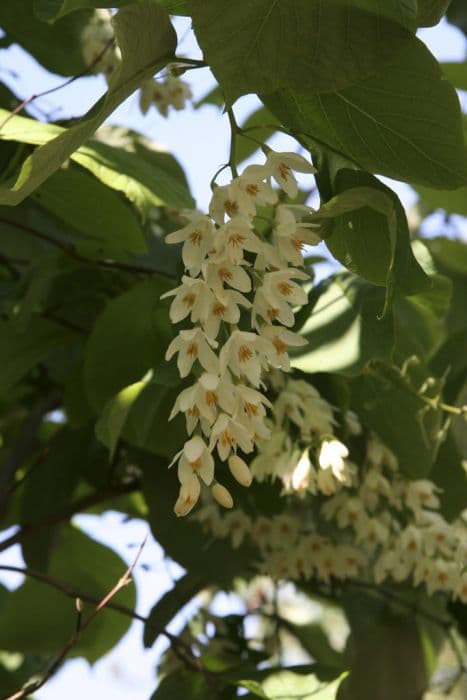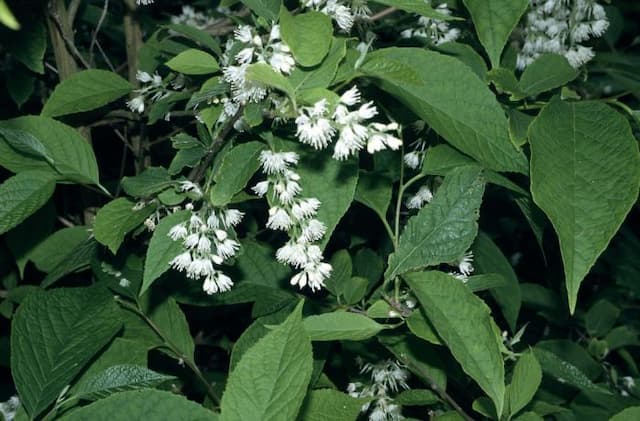Carolina Silverbell Halesia carolina Vestita Group

ABOUT
The Halesia carolina Vestita Group, commonly known as the Carolina silverbell, is a flowering plant notable for its beautiful appearance. The plant's most striking feature is its bell-shaped flowers, which are white and hang in small, delicate clusters. These blooms are especially attractive during spring when they emerge in abundance. The foliage of the Carolina silverbell is also quite handsome, with leaves that are broad and possess a fresh green color. As the seasons change, the leaves take on hues of yellow, adding a warm tone to the landscape before they fall. The bark of this plant is gray and can become furrowed as it matures, adding textural interest to the overall appearance. The flowers eventually give way to dry, winged fruits that provide visual interest into the late summer and autumn months.
About this plant
 Names
NamesFamily
Styracaceae.
Synonyms
Carolina Silverbell, Vestita Group Silverbell.
Common names
Halesia carolina 'Vestita', Halesia tetraptera var. vestita.
 Toxicity
ToxicityTo humans
The plant commonly known as Carolina silverbell doesn't have well-documented toxicity to humans. There are no significant reports of poisoning or toxic reactions from ingestion of the Carolina silverbell. However, like with any plant, it is generally advisable to avoid ingesting parts of plants that are not known to be edible, as they may cause digestive discomfort or allergic reactions in some individuals.
To pets
Carolina silverbell is not widely known to be toxic to pets either. There is limited information available regarding its potential toxicity to domestic animals such as dogs and cats. However, as with any plant, it is best to prevent pets from ingesting this plant, since it is not typically part of their diet and could potentially cause stomach upset or an allergic reaction in sensitive pets.
 Characteristics
CharacteristicsLife cycle
Perennials
Foliage type
Deciduous
Color of leaves
Green
Flower color
White
Height
30-40 feet (9-12 meters)
Spread
20-35 feet (6-10.7 meters)
Plant type
Tree
Native area
Southeastern United States
Benefits
 General Benefits
General Benefits- Aesthetic Appeal: Adds visual interest to landscapes with its delicate, white, bell-shaped flowers.
- Seasonal Interest: Produces attractive foliage and seasonal color changes, with some leaves turning yellow in the fall.
- Wildlife Habitat: Can provide nectar for pollinators such as bees and serves as a food source for birds when it produces seed capsules.
- Shade Provider: As a tree, it offers shade which can cool areas and provide shelter for underplantings.
- Erosion Control: The root system can stabilize soil and prevent erosion on slopes or banks.
- Cultural Significance: Sometimes planted in memory gardens or used in landscape design to create a sense of place or heritage because of its native status in the southeastern United States.
 Medical Properties
Medical PropertiesThis plant is not used for medical purposes.
 Air-purifying Qualities
Air-purifying QualitiesThis plant is not specifically known for air purifying qualities.
 Other Uses
Other Uses- The wood of Carolina silverbell can be used in woodworking and for making small wooden objects like handles, due to its hard and dense nature.
- Carolina silverbell is sometimes planted for its value to bees, as its flowers provide nectar when many other plants are not yet in bloom.
- The bark has been used for crafting and as a component in natural dyes for textiles, owing to its tannin content.
- The tree can be used in landscape design as a featured ornamental, especially renowned for its striking bell-shaped flowers.
- Its seed pods can be used for decorative purposes in dried floral arrangements and crafts.
- Due to its canopy shape, it can serve as a shade tree in residential gardens or small parks.
- Carolina silverbell is also utilized as a specimen for bonsai, especially in regions where it naturally grows.
- The leaves provide a rich source of organic matter when they fall, thus benefiting the soil quality as a natural fertilizer.
- Its resistance to honey fungus can make it an integral part of planting schemes designed to combat this garden pest.
- The tree's vertical growth habit can be used for screening views or creating privacy barriers in landscape design.
Interesting Facts
 Feng Shui
Feng ShuiThe Carolina Silverbell is not used in Feng Shui practice.
 Zodiac Sign Compitability
Zodiac Sign CompitabilityThe Carolina Silverbell is not used in astrology practice.
 Plant Symbolism
Plant Symbolism- Purity: The Halesia carolina, commonly known as the Carolina Silverbell, often symbolizes purity due to its elegant white bell-shaped flowers.
- Peace: The serene presence of the Carolina Silverbell in gardens can be associated with tranquility and peace.
- New Beginnings: Its spring blossoming can represent the start of new phases in life, just as it marks a new season in nature.
 Water
WaterThe Carolina silverbell should be watered deeply enough to moisten the soil to the root zone, typically requiring about 1 to 1.5 gallons of water per week during the growing season. Frequency of watering can be adjusted based on the weather, with less water needed during rainy periods and more during dry spells. Ensure that the soil is well-draining to prevent waterlogging. During the winter, when the plant is dormant, reduce watering significantly, but do not let the soil completely dry out.
 Light
LightCarolina silverbell thrives best in full sun to partial shade. An ideal spot would provide morning sunlight with some afternoon shade, or dappled sunlight throughout the day. Avoid deep shade as it can lead to poor flowering and a less robust plant.
 Temperature
TemperatureThe Carolina silverbell prefers moderate temperatures and can survive in USDA hardiness zones 5 through 8. It can tolerate minimum winter temperatures down to about -20 degrees Fahrenheit. The ideal temperature range for growth is between 60 to 80 degrees Fahrenheit.
 Pruning
PruningPrune Carolina silverbell to maintain shape and remove any dead or damaged branches; this is typically done in late winter or early spring before new growth begins. Pruning can also help to encourage more flowers. Perform structural pruning when the tree is young to establish a strong framework, and prune sparingly as the tree matures.
 Cleaning
CleaningNot needed
 Soil
SoilThe Carolina Silverbell prefers well-draining, organically rich soil with a slightly acidic pH between 5.5 and 6.5. A mix that contains peat, loam, and coarse sand would be ideal to ensure proper drainage and aeration. Fertilization can be done in spring with a balanced slow-release fertilizer to promote healthy growth.
 Repotting
RepottingCarolina Silverbell trees, being larger landscape plants, do not commonly undergo repotting in the same way that container plants do. They should be planted in an appropriately sized location where they can grow without needing to be moved. However, if grown in large containers, they may require repotting or root pruning every 3-5 years to manage root growth.
 Humidity & Misting
Humidity & MistingThe Carolina Silverbell does well in moderate humidity typical of outdoor environments. It doesn’t require any special humidity considerations beyond what is naturally present in its outdoor environment. Therefore, average ambient humidity will suit this plant just fine without the need for additional misting or humidifying procedures.
 Suitable locations
Suitable locationsIndoor
Not ideal indoor; needs full sun, moist soil, and large space.
Outdoor
Plant in moist, well-drained soil; full sun to partial shade.
Hardiness zone
4-8 USDA.
 Life cycle
Life cycleCarolina Silverbell (Halesia carolina Vestita Group) begins its life cycle with seed germination, typically in the spring after stratification. After germination, the seedling stage follows, where the plant establishes a root system and begins to grow its first leaves. As it matures into a sapling, the Carolina Silverbell develops a woody stem and branches, entering a juvenile phase where it continues to grow but does not yet flower. Reaching reproductive maturity after several years, the tree enters the adult stage, during which it produces distinctive white, bell-shaped flowers every spring. Following pollination, usually by bees and other insects, the flowers develop into winged fruit that contains seeds, which are then dispersed to begin a new cycle. The Carolina Silverbell can live for many decades, continuing to grow and reproduce annually until it reaches the end of its life span.
 Propogation
PropogationPropogation time
Spring to Summer
The most popular method of propagation for the Carolina silverbell, or Halesia carolina Vestita Group, is by seed. Seeds should be collected in fall as the capsules ripen and start to split. These seeds have a double dormancy, which requires a warm period followed by a cold period to break dormancy. To simulate this, seeds can be sown in a moist, well-drained seed-starting mix, then kept at 70 to 85 degrees Fahrenheit (21-29 degrees Celsius) for about two months before stratifying at 34 to 41 degrees Fahrenheit (1-5 degrees Celsius) for an additional three to five months. Afterward, the seeds can be sown outside or in pots in spring, where they will germinate and grow into beautiful specimens of the Carolina silverbell.



![Japanese snowbell [Marley's Pink Parasol]](/_next/image?url=https%3A%2F%2Fplants-admin.emdemapps.com%2Fimages%2Fplants%2F%2Fimages%2F604b602fef992.png&w=640&q=75)
